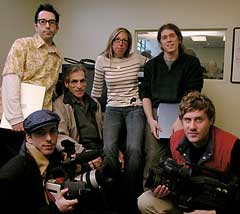Buffalo Paper Sets Up Video Production Studio to Create News Clips and Commercials
Artvoice publisher Jamie Moses has been waiting years to bring his true vision for Artvoice.com to life. More than a year and a half ago he decided the technology had advanced to the point that he could move his ideas out of his head and onto the World Wide Web.
The Buffalo weekly’s new site — Artvoice.com — launches this week, offering fresh multimedia content that could never appear in a print version. Here, you can hear and see Amy Goodman’s Pacifica radio program, “Democracy Now!” You can watch local musicians’ music videos or see Al Franken discuss his latest book; choose a movie by its trailer or see snippets of a newly opened play. You can watch commercials for a local restaurant, read Artvoice’s review of the place, and then check out its menu. You can watch “man on the street” interviews to learn what Buffalo natives think of current events, and you can see photo slide shows of the latest fashion trends.
You can tune in any time of day to hear Artvoice Radio, a streaming radio station on a continuous loop. Programming includes local news, syndicated talk shows, music and interviews with local politicians, activists, musicians and actors. You can also watch interviews on Artvoice TV. This week’s topic is casino gambling, and Moses interviews three casino opponents. Another regular TV feature is Tech Time, in which host Richard Suls explains the latest technical innovations. Suls is Artvoice’s system administrator and the Web site’s technical director.
Most of the content — except for Goodman’s show, the movie trailers and the real estate listings — is produced by Artvoice staff. Some of it, like the restaurant ad, is paid content. A section called “Cultural Zone” contains mostly editorial, non-paid pieces (though one local musician did pay to get a higher quality music video).
What you won’t see, however, are the bits of other Web sites that most annoy Moses. “There are no pop-ups, no banners and no click-throughs,” he says. In fact, forget about hyperlinks. Instead, most of the action takes place on the home page, with a tabbed layout inspired by Apple’s iTunes Web page. “They came up with that for me just in time,” Moses jokes.
You only have to click off of the main page to read the classifieds, event calendar, and contact information, or to get to the current or past issues of paper, which are available as PDF files laid out exactly like the printed version, complete with ads.
“The basic tenet of daily newspaper sites is that they don’t want to duplicate online what they put out on the street, which I don’t subscribe to at all,” Moses says. The online PDF format serves readers — if they can’t find the print version, they can get the same content online. It’s also good for advertisers, Moses says. “If you bought a full-color ad, it’s online too. The advertiser doesn’t get their money’s worth with dailies.”
Moses is a do-it-yourself kind of guy, so all of the work for the site, with the exception of the classifieds design and navigation, was done in-house. He had a high-speed T1 line installed in the office; purchased powerful computer servers; and hired a computer and Web expert to manage the back-end systems. And because he thinks big, he created a video production studio a year ago and hired four workers to learn how to produce and edit audio and video.
“I found people I intuitively thought had the talent, young kids, and then paid them to do nothing but sit in a room and play,” he says. “It was like Artvoice University. For a year, they didn’t bring in five cents.”
Today, the crew tapes theater previews; interviews citizens about recent events; and has even created a commercial for a local Mitsubishi dealer that ran on Buffalo TV stations and occupies a spot on Artvoice.com. Despite his company’s relative lack of television experience, Moses didn’t hesitate for a second with his ambitious venture.
“Most local TV producers around here suck,” he says. “Across the country in alternative media you’ll find a much higher level of creativity than in mainstream media or commercial production companies.”
To take full advantage of Artvoice.com, readers will need some technology of their own, including Flash, Adobe Acrobat Reader, Real Player and QuickTime. Older Internet browsers don’t support Flash, for instance, so users would have to upgrade to a newer version. But the technologies used are available for free and most new computers come already equipped with them, technical director Suls points out.
The number one limiter, though, is bandwidth. To watch or listen to anything on the site, people will need a fast connection, like DSL, cable modem or a T1/T3 line. Moses is not concerned. “None of it is designed for dial-up because I think dial-up is going to be dead soon,” he says. “People with dial-up at home just check e-mail. Most people who have T1s at work do their browsing there.”
A large part of Moses’s motivation for the site came from his desire to make money on the Web. The publication gets paid for video production services, and it charges a one-time fee to run ads for three months. After that time, companies can choose to update their content with new (paid) production, or to pay to keep the old content on the site.
Though Moses hasn’t come up with a monetary figure for his start-up expenses, he’s not worried about recouping costs because he’s certain the venture will succeed. Moses would also like to see other alternative papers follow his model and plans to create a “just add water” kit to get them started. “There’s no use in other people trying to recreate what we’ve done.”
Amy Souza is a freelance writer living in Pittsburgh.

